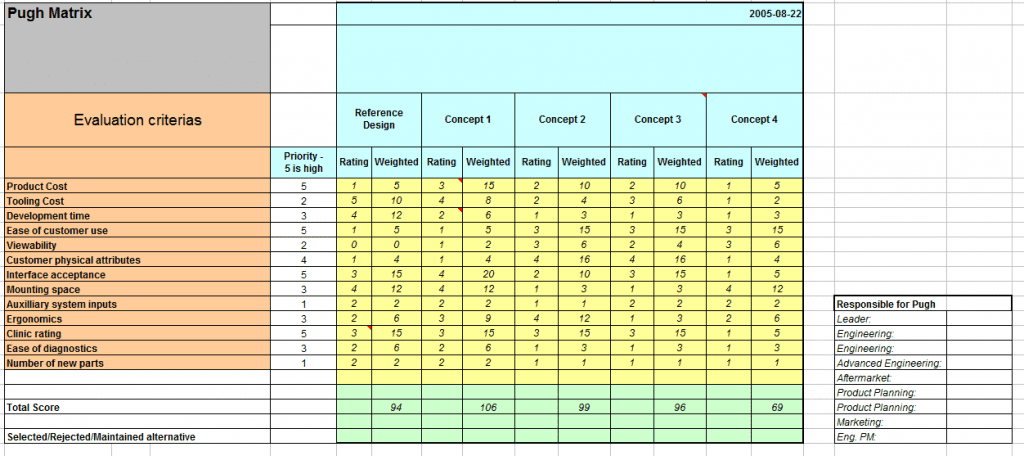Pugh Matrix
Our last blog discussed un-weighted decision matrix. In this blog, we are going to look at a weighted version called the Pugh Matrix. This matrix, named after Stuart Pugh, is commonly used to evaluate design concept alternatives though it need not exclusively be used in these applications, we are going to demonstrate the use in a concept selection decision. It does not matter the project management method (agile or traditional) or the product under development, determining the appropriate concept is the starting point and the Pugh matrix can help.
Pugh Matrix Team
First, it is important to note the team constituents, look at the small box on the right-hand side. We will need a cross-functional group of people that are able to articulate their perspectives regarding the design. In this case, the representatives of the groups that will have to work with the final product are bringing their expertise to focus on the design at hand. This means we are not looking at the attribute from a single perspective, such as that of the development group. We are looking at it from the entire development steam. For example, consider that the development tooling costs are low, but perhaps the proposed product requires special tooling for manufacturing or aftermarket. This should come out in the review of the designs.
Weighted Attributes in Pugh Matrix
Next, weighted means that all of the attributes we are considering are not of equal value. We will compare the strategies we generate, in our case design concepts, against these attributes; some of the attributes will have a greater impact on our (or customer) level of satisfaction than others. For example, perhaps we value cost attributes over some of the feature content or maintainability. If that is the case, the emphasis on the cost variable will be addressed in the matrix and the final number presented by the matrix will include the ranking of this desire.
In the graphic below, you can see the evaluation criterion on the left column; these are the attributes against which we are going to compare our design. In this example, the highest value evaluation criteria (priority 5) are:
- product cost
- ease of use
- interface acceptance
- clinic rating
This weighting (priority) becomes a multiplier for the rating and produces the end value for the attribute. For example, we would expect a priority value of 5, to produce some weighted value of 20-25 as that would mean we have found a good solution for the highest priority attribute (our solution then holds a ranking of 4-5 also the top end of the scale). If our priority or weighted level 5 produces a 10 (a rating of 2) then we have not matched the design to this objective very well.
In this particular instance, we are also comparing the reference design, the present situation against four other concepts. If we cannot do better than what we presently have in terms of the product, then perhaps this project is not viable.
Pugh Matrix Results
In this comparison, we see that Concept 1 appears to be the better solution, though not by a great measure. In some cases performing this evaluation then leads to ideas of ways to take the best each concept and further refine. We may find an easy adaptation possible with one of the concepts that will net the stronger benefit found in another.
This evaluation method helps focus the team on the top level objectives of the product development. If we have a suitable corporate culture; that is one in which the team members are engaged and believe they can make a difference, we can draw from this wealth of cross-functional experience to drive the design. We bring the power of our talented people to bear to find the optimum solution through this fairly inexpensive technique.

